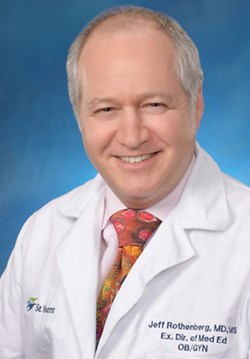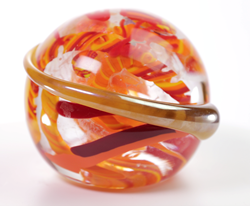Weizmann alumnus Dr. Jeffrey Rothenberg wears many hats. Over the course of a single day, you might find him seeing patients, leading an executive hospital meeting, teaching medical students, or delivering newborns. You might also find him practicing an entirely different occupation: glassblowing.
An accomplished obstetrician-gynecologist, a celebrated professor, and a prolific artist, Dr. Rothenberg says his vocations and his avocation are integral to who he is. And while friends, family, and colleagues marvel at his ability to use both sides of his brain, he sees the two as intertwined. The arts and humanities, he believes, nurture skills such as observation, introspection, and empathy—all of which make physicians better healers.

Dr. Jeffrey Rothenberg
His appreciation for these “soft” skills deepened when he took up glassblowing some 20 years ago, but it began much earlier—with his own training as a scientist at the Weizmann Institute. “My professional identity as a young man was cut by the Weizmann Institute and the people I engaged with there,” he said. “It was the springboard to my entire career and foundational to the doctor and educator I am today.”
Hailing from Gary, Indiana, Dr. Rothenberg first discovered the Institute while spending time in Israel as an undergraduate student. Later, as a participant in the Institute’s Karyn Kupcinet International Summer School, he conducted research in the laboratory of Prof. Ernest Winocour, then a member of the Department of Virology. “I fell in love with it,” he said of his introduction to Weizmann.
An Entrée to the World
After completing his bachelor’s at Indiana University, he returned to the Institute, accompanied by his wife, Joani, to pursue his master’s in biophysics. He soon found “a wonderful mentor” in world-renowned biochemist Prof. Meir Wilchek. With Prof. Wilchek’s guidance, he focused on developing the chemistry of nucleic acids. His goal was to create an assay, or molecular analysis, that would identify the presence of a specific parasite in humans. This basic science research showed great promise for the development of a clinical diagnostic tool. “At that point, there weren’t molecular tests for infectious diseases, so our work was at the cutting edge,” he explained.
As they undertook innovative investigations, Prof. Wilchek pushed his mentee to think critically and to broaden his interests. “We would meet in the library before the day started,” Dr. Rothenberg recalled, “but Meir would only allow me to read things that weren’t in the discipline that I was studying.” His professor also encouraged him to partner with other labs. The perspectives of scientists working in different fields allowed him to take his experiments to new heights.

Prof. Meir Wilchek and Dr. Jeffrey Rothenberg on the Weizmann campus, circa 1985.
In addition to the multidisciplinary atmosphere, Dr. Rothenberg was inspired by the international character of the campus. “There were students and professors from across the globe,” he said. “It showed me how science could be an entrée to the rest of the world and help bring together people from various backgrounds.”
“My professional identity as a young man was cut by the Weizmann Institute and the people I engaged with there. It was the springboard to my entire career.”
Over the next two years, the Institute instilled in him the values of camaraderie and teamwork: “The labs were very team-based, so you knew that when you published a paper, you didn’t do it alone. Learning that lesson early on in my career, in a place that fosters collaboration, was super important. As the old adage says, ‘If you see a turtle on a fence post, you know it didn’t get there by itself.’”
Outside the lab, he also formed deep bonds with other students, whether having wine and cheese at the pool behind Weizmann House, enjoying down time in the tzrifim (the rustic huts where students lived at the time), participating in the Va’ad (student government), or listening to a classical concert on campus.
The environment was also ideal for his wife, Joani, who had recently completed her bachelor’s in art and was beginning a master’s program in art therapy in a combined Israeli/U.S. program through Lesley College. Joani had the opportunity to help teach in the Agam Program, an educational course for preschool students created by Israeli artist Yaacov Agam, and developed and implemented by the Weizmann Institute’s Department of Science Teaching. The course teaches young children to stimulate their visual skills, and exemplifies the outside-the-box thinking promoted by the Institute.
“Joani and I found Weizmann to be a place where the arts were celebrated along with the sciences,” Dr. Rothenberg recalled.
A Creative Approach
After earning his MSc in 1987, he moved to Boston. While Joani completed her master’s, he worked for Advanced Magnetics, Inc., a company founded by Dr. Ernest Groman, a visiting scientist whom he had met at the Institute. A year later, he wanted to continue his studies, but he questioned whether to pursue basic scientific research or medicine. He turned to his mentor, Prof. Wilchek: “Meir was instrumental in helping me decide to become an MD.” He took his professor’s advice and never looked back.
He returned to Israel to attend Tel Aviv University’s Sackler School of Medicine, graduating first in his class, followed by a residency at Northwestern University. He then became a prominent physician at Indiana University School of Medicine, currently the largest medical school in the country. He later served as the school’s president.

A glass sculpture by Dr. Jeffrey Rothenberg.
As an educator, he embraced the Weizmann faculty’s philosophy of “treating learners as equals.” “It has helped me become a successful mentor to the students that I have trained, which has been the most rewarding aspect of my career,” he said.
His glassblowing added another dimension to his medical practice and to his teaching. 20 years ago, he experienced one of the most challenging weeks of his career: three infants he was treating in the OB intensive care unit passed away. His wife recognized his depression and signed him up for an art class. As a surgeon, he enjoyed using his hands in a creative way—and glass proved to be the perfect medium. Since then, he has created hundreds of pieces that have been on display in his home, in private collections, in museums, and in hospitals spanning from Indiana to Kenya.
Paying It Forward
In addition to his own artistic pursuits, Dr. Rothenberg has made it his mission to incorporate the arts and humanities into medical school curricula. From establishing arts publications to creating a program that takes students to the Indianapolis Art Museum, he sees these outlets as tools to help build “more empathetic healers and caregivers.” In recognition of his important efforts, he received the American College of Obstetrics & Gynecology’s Arnold P. Gold Foundation Humanism in Medicine Award in 2015.
While pushing his students out of their comfort zones, he continues to challenge himself. Last summer, he accepted a new position as President of the St. Vincent College for Health Professions and Executive Director of Medical Education at St. Vincent Hospital. The school and the hospital provide training for medical students, residents, and fellows, as well as students pursuing radiography, emergency medical services, and other fields.
Committed to nurturing the next generation of health care professionals, he still draws on his Weizmann education. About a year ago, he and Joani visited the Institute with their four children, ages 17 to 27. While exploring his old stomping grounds, he found himself in awe of the Davidson Institute of Science Education. Watching children discover that “science could be exciting and cool brought me so much joy,” he said. It was a powerful reminder of the humanistic, forward-looking approach to teaching that he learned from his Weizmann professors. “You can’t just sit back on your laurels,” he said. “You have to plant the seeds for tomorrow. I will forever be thankful for the people at the Weizmann Institute for giving me that chance.”
